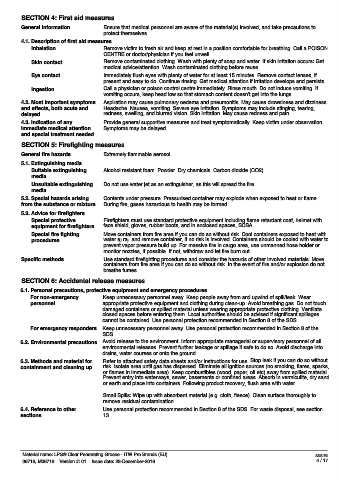Page 55 - LPS Food Grade Approved Products - All Task Solutions 2019
P. 55
SECTION 4: First aid measures
General information Ensure that medical personnel are aware of the material(s) involved, and take precautions to
protect themselves.
4.1. Description of first aid measures
Inhalation Remove victim to fresh air and keep at rest in a position comfortable for breathing. Call a POISON
CENTRE or doctor/physician if you feel unwell.
Skin contact Remove contaminated clothing. Wash with plenty of soap and water. If skin irritation occurs: Get
medical advice/attention. Wash contaminated clothing before reuse.
Eye contact Immediately flush eyes with plenty of water for at least 15 minutes. Remove contact lenses, if
present and easy to do. Continue rinsing. Get medical attention if irritation develops and persists.
Ingestion Call a physician or poison control centre immediately. Rinse mouth. Do not induce vomiting. If
vomiting occurs, keep head low so that stomach content doesn't get into the lungs.
4.2. Most important symptoms Aspiration may cause pulmonary oedema and pneumonitis. May cause drowsiness and dizziness.
and effects, both acute and Headache. Nausea, vomiting. Severe eye irritation. Symptoms may include stinging, tearing,
delayed redness, swelling, and blurred vision. Skin irritation. May cause redness and pain.
4.3. Indication of any Provide general supportive measures and treat symptomatically. Keep victim under observation.
immediate medical attention Symptoms may be delayed.
and special treatment needed
SECTION 5: Firefighting measures
General fire hazards Extremely flammable aerosol.
5.1. Extinguishing media
Suitable extinguishing Alcohol resistant foam. Powder. Dry chemicals. Carbon dioxide (CO2).
media
Unsuitable extinguishing Do not use water jet as an extinguisher, as this will spread the fire.
media
5.2. Special hazards arising Contents under pressure. Pressurised container may explode when exposed to heat or flame.
from the substance or mixture During fire, gases hazardous to health may be formed.
5.3. Advice for firefighters
Special protective Firefighters must use standard protective equipment including flame retardant coat, helmet with
equipment for firefighters face shield, gloves, rubber boots, and in enclosed spaces, SCBA.
Special fire fighting Move containers from fire area if you can do so without risk. Cool containers exposed to heat with
procedures water spray and remove container, if no risk is involved. Containers should be cooled with water to
prevent vapor pressure build up. For massive fire in cargo area, use unmanned hose holder or
monitor nozzles, if possible. If not, withdraw and let fire burn out.
Specific methods Use standard firefighting procedures and consider the hazards of other involved materials. Move
containers from fire area if you can do so without risk. In the event of fire and/or explosion do not
breathe fumes.
SECTION 6: Accidental release measures
6.1. Personal precautions, protective equipment and emergency procedures
For non-emergency Keep unnecessary personnel away. Keep people away from and upwind of spill/leak. Wear
personnel appropriate protective equipment and clothing during clean-up. Avoid breathing gas. Do not touch
damaged containers or spilled material unless wearing appropriate protective clothing. Ventilate
closed spaces before entering them. Local authorities should be advised if significant spillages
cannot be contained. Use personal protection recommended in Section 8 of the SDS.
For emergency responders Keep unnecessary personnel away. Use personal protection recommended in Section 8 of the
SDS.
6.2. Environmental precautions Avoid release to the environment. Inform appropriate managerial or supervisory personnel of all
environmental releases. Prevent further leakage or spillage if safe to do so. Avoid discharge into
drains, water courses or onto the ground.
6.3. Methods and material for Refer to attached safety data sheets and/or instructions for use. Stop leak if you can do so without
containment and cleaning up risk. Isolate area until gas has dispersed. Eliminate all ignition sources (no smoking, flares, sparks,
or flames in immediate area). Keep combustibles (wood, paper, oil etc) away from spilled material.
Prevent entry into waterways, sewer, basements or confined areas. Absorb in vermiculite, dry sand
or earth and place into containers. Following product recovery, flush area with water.
Small Spills: Wipe up with absorbent material (e.g. cloth, fleece). Clean surface thoroughly to
remove residual contamination.
6.4. Reference to other Use personal protection recommended in Section 8 of the SDS. For waste disposal, see section
sections 13.
Material name: LPS® Clear Penetrating Grease - ITW Pro Brands (EU) SDS EU
06716, M06716 Version #: 01 Issue date: 28-December-2016 4 / 17

